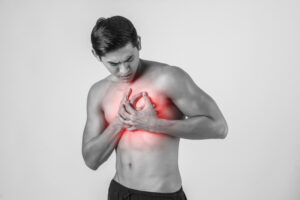What is a Heart Attack?
Myocardial infarction, another name for a heart attack, is a severe medical emergency that happens when blood flow to a portion of the heart muscle is cut off. Due to this obstruction, oxygen cannot reach the heart tissue, which can damage or kill the affected heart muscle.
If not treated quickly, a heart attack can lead to severe complications or even death.

Causes
Coronary artery disease (CAD) is the leading cause of heart attacks. When plaque—a mixture of fat, cholesterol, and other materials—accumulates in the coronary arteries, which carry blood to the heart, coronary artery disease (CAD) results. This buildup is called atherosclerosis.
Common Causes Include:
1. Plaque Rupture: A blood clot may form and obstruct blood flow when plaque in the arterial wall ruptures.
2. Coronary Artery Spasm: When a coronary artery contracts momentarily, blood flow may be reduced or even stopped.
3. Additional Causes: Heart attacks can also result from severe infections, trauma, or drug use (such as cocaine).
Symptoms
Although each person’s heart attack symptoms are unique, typical indicators include
Common Symptoms:
1. Chest pain or discomfort (which could feel like a squeeze, tightness, or pressure)
2. Pain that travels to the jaw, neck, back, arm, or shoulder
3. Breathlessness
4. Vomiting or feeling queasy
5. Sweating (cold sweat)
6. Dizziness or lightheadedness
7. Exhaustion or unusual fatigue
Note: Some people may have silent heart attacks with little to no symptoms, particularly women, the elderly, or diabetics.
Diagnosis
To diagnose a heart attack, doctors employ several instruments and examinations:
1. An electrocardiogram, also known as an EKG or ECG, measures the electrical activity of the heart.
2. Blood tests: Check for enzymes that are released when the heart muscle is injured, such as troponin.
3. Coronary angiography: Using X-ray imaging and a dye, blocked arteries are seen.
4. Echocardiogram: Produces images of the anatomy and function of the heart using sound waves.
Handling
To minimize heart damage, treatment must be initiated promptly. Typical therapies consist of:
Treatments for Emergencies:
1. Aspirin: Aids in lowering blood coagulation.
2. Enhances the heart’s blood flow with nitroglycerin.
3. Blood oxygen levels are raised by oxygen therapy.
Medical Operations:
1. Angioplasty and Stenting: A stent is inserted to keep the blocked artery open after it has been opened with a balloon.
2. Through Coronary Artery Bypass Surgery (CABG), doctors open a new blood vessel to bypass the clogged artery.
.
Medications:
1. Heparin and other blood thinners
2. Beta-blockers
3. ACE inhibitors
4. Statins (for lowering cholesterol)
Recuperation Following a Heart Attack
Changes in lifestyle, medication, and occasionally cardiac rehabilitation—a program under supervision to help strengthen the heart—are all part of recovery.
How to Avoid a Heart Attack
Maintaining a healthy lifestyle and controlling risk factors can help prevent a heart attack:
Preventive Measures:
1. Give up smoking.
2. Consume a heart-healthy diet that is low in sugar, salt, and saturated fat.
3. Regularly work out
4. Keep your weight in check.
5. Control blood pressure, cholesterol, and diabetes
6. Limit alcohol intake
7. Manage stress
In conclusion
A heart attack is a potentially fatal illness that needs to be treated right away. Reducing risk and enhancing heart health require an understanding of the signs, causes, and preventative measures. Call emergency services right away if you or someone you know exhibits symptoms of a heart attack.
Eat a heart-healthy diet low in salt, sugar, and saturated fat.
Exercise regularly and avoid smoking or excessive alcohol.
Manage stress, blood pressure, cholesterol, and diabetes effectively.
Maintain a healthy lifestyle by eating well, exercising regularly, and managing stress to reduce the risk of a heart attack.